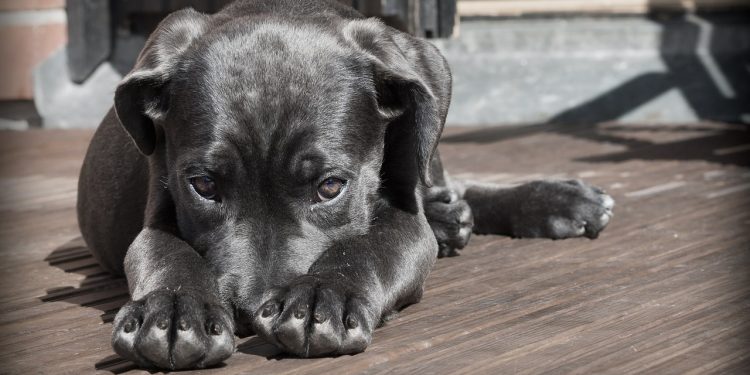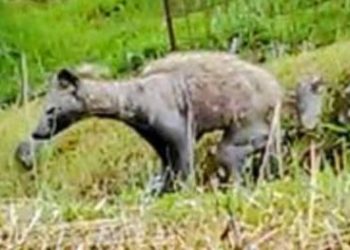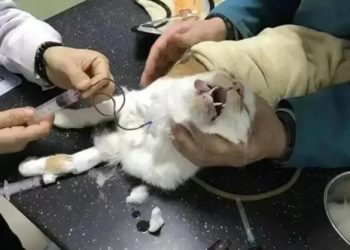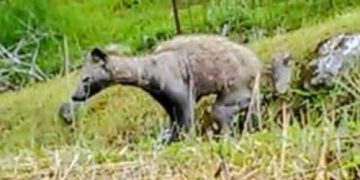How to recognize signs of distress
One key mistake people make is that they often miss signs that dogs are stressed or anxious — often a precursor to aggressive behavior. According to the experts, a stressed-out pup may show she’s scared by licking her lips, yawning, lifting a front paw, shedding hair, scratching, shaking, panting or pacing. Her eyes can change, too: When we used to take our other dog, Henry, to the dog park, he would sometimes get what my partner and I referred to as “crazy eye” — his eyes would bug out, and you’d see more of the whites. I didn’t realize until recently that this is a phenomenon called “whale eye,” and it’s often a sign of doggie distress.
his doesn’t mean that every time your dog pants, yawns or lifts a paw, The’s on the verge of a breakdown. Dogs pant when they’re hot, too. Some dogs, such as pointers, lift their front paws when they pick up a scent. Yawning can also mean, of course, that your dog is tired. To understand what a dog’s body language and behavior are saying, “you have to look at the dog’s whole body, and you have to think about the context in which you’re in,” said psychologist Sarah Byosiere, director of the Thinking Dog Center at CUNY Hunter College in New York City.
So if your dog is panting but he isn’t hot or winded, or if your dog is yawning but not seemingly tired, yes, he could be stressed. And especially if you’re seeing a constellation of these stress behaviors at once, that’s a good sign that your pup is uncomfortable, Dr. Byosiere said.
If your dog is out of sorts, what should you do? First, try to figure out what might be causing his discomfort, said psychologist Angie Johnston, director of the Boston College Canine Cognition Center and Social Learning Laboratory. Are you in an unfamiliar place? Is your dog meeting new people or dogs? Once you have an idea as to what might be making your pup uncomfortable, “pull back from that activity,” she said, and see if those anxious behaviors dissipate.
Tail movements are another thing we think we understand but typically don’t. “The most common misconception, by far, is that tail-wagging definitely means the dog is happy,” Dr. Johnston said. If a dog’s tail-wagging is fluid and relaxed, then yes, she’s probably content, she said — but if the tail is wagging only slightly, and seems rigid, then it may be a sign that she is about to be aggressive. Research suggests, too, that when a dog’s wagging tail leans more to the right, she’s happy, but if it leans more to the left, she’s feeling hostile.
How to manage a dog’s social life
Many of the mistakes we make as dog owners revolve around how we handle their social interactions. We often don’t recognize the signs — panting, stiff tail-wagging, lip-licking, yawning — that our dog is uncomfortable around other people or dogs and needs help. Responding to their cues might mean asking other people to give your dog space. Maybe it means leaving the dog park and going home. “Probably the worst thing to do is to not do anything,” Dr. Byosiere said. If you don’t step in, you’re also increasing the risk that they could become aggressive.
One reason we make these errors is that we tend to assume dogs are more extroverted than they really are. “People who love dogs love to meet new dogs. But not all dogs like to meet new people or dogs,” said Brian Hare, an evolutionary anthropologist at Duke University who founded their Canine Cognition Center. If you want to meet a dog, first ask her owner if it’s OK — and respect them if they say no.
If the owner says it’s OK, approach the dog slowly. Stop a few feet away, kneel or crouch down, and see if the dog approaches you, Dr. Hare suggested. If he doesn’t — and especially if he looks or walks away — take that as a sign that you shouldn’t get any closer. If you see some of the distress signals mentioned earlier, that’s also a sign that he’s feeling nervous and that you should back off. And don’t approach a dog with your hand outstretched, Dr. Hare said — this can trigger aggression in dogs that have been mistreated, and it could lead to a bite. Instead, hold your hand out in a fist, or don’t hold extend a hand at all.
Don’t anthropomorphize your pup
The experts told me that we often attribute our dog’s actions to feelings they’re not really having. I have always assumed that Ozzy licks my face because he loves me. But — and boy, was I sorry to learn this — dogs often lick faces because they’re hoping to get a taste of what you recently ate, said Evan MacLean, an evolutionary anthropologist and comparative psychologist at the University of Arizona. (This stems from the behavior of young wolves, who lick the insides of their mothers’ mouths so that their moms regurgitate food for them to eat. Which explains why dogs do gross things like eat people’s vomit.)
Another mistake we make is assuming that dogs like the same things we do. Yes, some dogs love to be petted and snuggled. But many don’t. Ozzy sometimes rolls onto his back when my 11-year-old pets him, and that may be because he’s feeling uncomfortable, not because he wants a belly rub, Dr. MacLean said — although admittedly, he said, it can be hard to tell the difference.
Also, that guilty expression you see on your dog’s face after she’s done something “bad”? Research shows it’s not really a sign that she feels sheepish — she’s probably just responding to your anger. “Dogs show this look as a response to their person’s behavior or tone, not to their doing something we consider wrong,” said cognitive scientist Alexandra Horowitz, who directs the Barnard College Dog Cognition Lab.
Ultimately, dogs understand us far better than we understand them, Dr. Johnston said. Over thousands of years of domestication, they’ve become “really good at reading our emotions,” she said, but “I don’t think that it’s worked as much in the other direction.” To do right by our beloved canines, we really need to get to know them — and their weird little cues. I realize now that Ozzy has been communicating his needs to us pretty clearly but that we just haven’t been receptive — and now that we’re paying more attention, he’s become much better behaved. We’re still working on his proclivity toward burrito theft, however. That one is harder to tame.




















